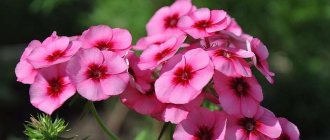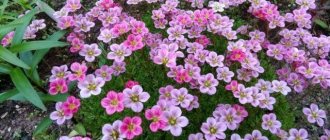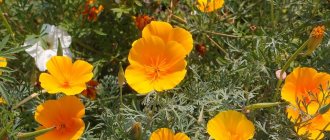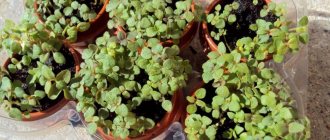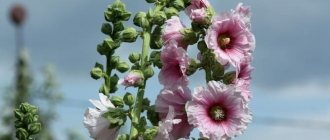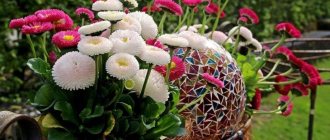What varieties of dichondra are grown from seeds?
Dichondra is an exotic climbing plant. Evergreen creeping stems look great as carpets in flowerbeds and as flower cascades on terraces and balconies.
There are about 10 varieties of dichondra. Flower growers have fallen in love with two species that are quite common in garden plots. These are the Silver Falls and Emerald Falls varieties.
Silver Falls is a plant with long three-meter stems with dense foliage and green-yellow flowers.
The shoots of the green waterfall are slightly longer.
Both varieties are densely covered with flowers that harmonize perfectly with the leaves.
Mowing the lawn with dichondra
Many people use dichondra as a lawn alternative. This way, you can mow the plant to the height you want to maintain it. For the best appearance of dichondra, mow approximately every two weeks at a height of 3-5 cm. This will create a dense grass cover with small leaves and help protect the seeds from weeds. Just like with lawn grass, don't cut too much dichondra at one time. Cover plants to give them a “scalped” appearance. It's usually best to bag your grass clippings if you only mow them once every two weeks.
What does dichondra look like, photo of a flower
Dichondra is a perennial plant native to tropical and subtropical forests.
The roots are often located very close to the surface of the earth (and often on the surface itself) and are well adapted to weather changes.
From a low bush, stems grow from 1 to 3 meters long, depending on the variety and place of growth.
Dichondra blooms throughout the summer with small flowers of different shades. Decorative round leaves can be painted in rich silver or green colors.
Common varieties
Two of the available ten varieties are common in Russia.
Emerald Falls
The Dichondra variety Emerald Falls is distinguished by the fact that it needs significantly more moisture for proper cultivation. The leaves of the plant are colored rich green. Feels great in partial shade, while the lack of light has virtually no effect on the color of the leaves. As a rule, this type is chosen when there is good soil cover. At the same time, dichondra ampelous Emerald Falls also looks impressive in hanging flowerpots, thereby justifying its name.
Emerald waterfall in a composition with flowering plants
Silver Falls
This species has leaves with a beautiful silver tint. The stems of Dichondra Silver Falls are long and the plant needs sunlight to produce its silvery color. It is drought resistant. Resistant to pests and adverse atmospheric conditions.
As a rule, Dichondra silvery waterfall is grown in containers and flowerpots. Hanging silvery branches look unusual and are a decoration for any garden design.
Dichondra silvery waterfall growing in a container
When to plant dichondra seedlings, in what month
In order to get healthy, full-fledged seedlings by spring, which will later grow into a gorgeous drooping or creeping bush, it is better to start sowing dichondra at the very beginning of winter.
Dichondra develops slowly, so it needs proper and complete care when grown at home, which will help the plant increase its vegetative mass by spring.
You can sow dichondra in 2022, starting from the very first days of January until the end of winter, choosing the planting day according to the lunar calendar.
Growing and care
Dichondra is undemanding in care. There are no significant risks in the development of diseases; pests do not like the plant. However, it is necessary to avoid excessive moisture, as the roots of the plant may rot.
In spring the plant grows slowly, but in early summer it gains strength and accelerates the growth of shoots. An interesting feature of the long flexible shoots of the plant is their resistance to fairly strong winds, thanks to which the shoots do not break, but only sway gently.
Watering, fertilizing
This plant comes from semi-desert lands, so it copes well with temporary drought, but in containers it should be watered regularly, but not overwatered! On hot summer days it requires systematic, moderate watering. She also likes to spray the shoots with water from a spray bottle (the water needs to settle, otherwise unsightly streaks and spots may appear on the leaves).
Since the plants grow intensively and produce a lot of leaves, they need to be fertilized regularly - once every 2 weeks. You can use vermicompost or multicomponent fertilizer to feed dichondra. If they grow in company with flowering plants, then the dose and frequency of feeding is adjusted to the main species.
Attention! If an aqueous solution of fertilizer is used for feeding, you need to apply it very carefully, not to wet the leaves when watering, because after contact with fertilizers the leaves turn brown and lose their beauty.
Care in autumn, wintering
Dichondras are perennials in nature. However, they are not frost-hardy and in our climate are grown as annuals.
At the end of October, the plant still pleases with silver and vigor. Unfortunately, dichondra suffers in the fall because it cannot tolerate temperatures dropping below 10 °C. Since the plant will not survive the winter, at the end of November the wilted stems are cut off with scissors and thrown into the composter.
However, it is possible to provide the dichondra with wintering. It is enough in the fall (when the temperature drops to 10 ºC) to move the pots to a bright, not too warm room with a temperature of +15+18 ºC. Dichondra is watered sparingly in winter. Unfortunately, at home, dichondra does not always overwinter in good shape, but it’s worth a try.
Trimming
In the fall, you can trim the shoots of dichondra, this can also be done in the spring. The shoots can be very long, if this is not very suitable, you can cut them to the desired size. New shoots will soon appear in the leaf axils.
Planting a flower for seedlings depending on the region
The climatic conditions of the regions differ from each other and make their own adjustments to the exact timing of sowing ornamental plants.
In the southern regions, spring comes earlier and allows gardeners to plant seedlings in open ground or in flowerpots already in mid-spring, when warm weather sets in. In these parts, seedlings can be sown immediately after the New Year.
In Central Russia, sowing dates move a little closer, so they are planted as usual in mid-January.
The harsh climate of the northern regions and the Urals does not allow planting seeds early, but you should not delay the start of cultivation either, otherwise the green mass will not gain the required volume. In these regions, flowers are usually planted in late January - early February.
Possible problems
Regardless of what type of flower is grown - Dichondra Silver Falls or Emerald Falls, the grower may encounter a problem that the leaf begins to shrink and curl. This can happen as a result of insufficient watering.
In addition, many novice gardeners are concerned about the question of why dichondra begins to lose color. This is especially true for the Silver falls variety. This happens mainly due to the lack of lighting, to which the silver dichondra reacts very strongly. Bright lighting and proper care will help maintain the attractiveness and richness of greenery.
Note! The plant is highly resistant to various diseases and pests. The flower copes excellently with all misfortunes, since it is a weed by nature.
When to plant dichondra seedlings in 2022 according to the lunar calendar
For a long time, flower growers and gardeners, before starting work, turn to the advice of the lunar calendar compiled by astrologers.
Favorable days for planting dichondra in 2022 according to the lunar calendar
In order for seedlings to become strong, they must form a healthy root system and grow green mass. The most suitable phase for sowing seeds for seedlings is the waxing moon phase.
The table below shows recommended planting dates.
| Month | When to plant |
| January | 4, 5, 6, 7, 8, 9, 10, 11, 12, 13, 14, 15 |
| February | 2, 3, 4, 5, 6, 7, 8, 9, 10, 11, 12, 13, 14, 15 |
| March | 3, 4, 5, 6, 7, 8, 9, 10, 11, 12, 13, 14, 15, 16, 17 |
When to plant dichondra seedlings in 2022 according to the lunar calendar is not worth it
According to the observations of astrologers, the following numbers will be unfavorable days for planting in 2022:
| Month | When not to sow |
| January | 1, 2, 3, 16, 17, 18, 19, 21, 22, 25, 26, 30, 31 |
| February | 1, 16 |
| March | 2, 18 |
What is needed for planting dichondra seedlings
Planting seeds is not difficult, but it does not tolerate neglect.
In order for the seedlings to turn out healthy, you need to take care of them already at the stage of selecting a variety and preparing the seeds for sowing. The quality of the future flower garden largely depends on these actions.
How to choose the right dichondra variety?
The choice of variety to grow depends on several nuances: what kind of plant you want to grow, the characteristics of the variety and the climatic conditions of the region where planting is planned.
It is also necessary to pay attention to weather conditions and weather forecasts. Nowadays, the weather quite often presents surprises to summer residents.
Weed, disease and insect control
The first line of defense is a neatly maintained lawn, created through proper fertilization, mowing and watering. With proper care, there will be no weeds on the dichondra, as it will grow into a dense mat with no room left for weeds.
A healthy Dichondra lawn, planted in the right conditions and properly maintained, will in most cases be free of weeds, diseases and pests.
Warning! Do not use broadleaf herbicides on dichondra as they will kill your lawn.
Dichondra can become susceptible to pests such as flea beetles, cutworms and weevils when stressed due to improper care or adverse weather conditions.
There are insecticides on the market to kill these pests, but prevention through proper care is the best line of defense. After all, you chose a lawn alternative for a reason, usually to avoid the use of chemical products.
Organic pest control methods you may encounter include homemade "pesticides" such as garlic/onion sprays, dish soap, cayenne pepper.
Planting dichondra seedlings at home, step by step photos
Once the seeds and soil are prepared, you can begin planting the seeds. Do this in several ways.
Sow in containers
This is the most common planting method.
The treated substrate is poured into a container or other container. Grooves with a depth of no more than 5 mm are made in it. The distance between them should be about 3 cm.
The seeds are carefully placed in the grooves, the distance between them should be 1.5-2 cm.
The crops are covered with a layer of soil.
Containers can be covered with glass or placed in a transparent plastic bag to create a greenhouse effect before germination.
How to sow in a “snail”
A very convenient method of planting, since planting seedlings after it is quite easy.
To form a snail, you can use polyurethane foam and toilet paper or a strip of fabric 10-12 cm wide. The earth is laid on this base in a layer of 1 cm.
The seeds are carefully placed on it at a distance of about 2 cm, and a thin layer of earth is placed on top.
The strip with the seeds is rolled into a snail and placed in a bowl. Water is poured on top. To obtain a greenhouse effect, the container with the snail is covered with a transparent bag and placed in a warm place until the sprouts appear.
RECOMMENDATION! To maintain moisture longer, pour a little water into the bottom of the container with the snail.
How to care for dichondra seedlings
Caring for the flower is simple, and even an inexperienced gardener can handle it.
Caring for dichondra immediately after sowing until emergence
After the seeds are sown, the containers with them are placed in a transparent bag or covered with glass and placed in a well-lit place.
Every day the container is ventilated for 20-30 minutes and watered as needed.
Care after entrances appear
After germination, care does not change much. The package is removed from the container and activities are carried out: watering, loosening, fertilizing and picking.
Reproduction of dichondra
As already mentioned, in addition to the seed method for dichondra propagation, vegetative methods are also used - cuttings and rooting of layering, and these methods are much simpler and more effective than generative propagation. After pinching and autumn pruning of the vines, the stem apical segments remain - cuttings that take root easily. Over the winter they will grow on your windowsill, and in the spring they can be planted in a permanent place.
As for the propagation of dichondra by layering, you don’t have to put in any effort: the stems of the plant have additional roots, which themselves grow into the soil, rooting the stem. This stem can be separated and replanted at any time.
How to care for dichondra seedlings
With proper care, the first shoots will appear within 10-15 days and caring for them includes the following measures
Hardening
You should not immediately remove the shelter from the containers. The seedlings need to be gradually accustomed to fresh air. This is done gradually, ventilating the containers daily until their time without shelter reaches 10-12 hours.
Watering
It is very important to ensure that the soil does not dry out or become waterlogged. Water the dichondra with settled water at room temperature, spraying it with a spray bottle.
Top dressing
You can feed it already on the 10th day after germination. To do this, it is better to use special mineral fertilizers in liquid form based on humates. For example, potassium humate, Gumi-OMI, etc.
How does it reproduce
Dichondra is grown not only from seeds, although this method is very popular among gardeners. In addition, the plant can be propagated by cuttings or by rooting layering.
Dichondra ampelous growing from seeds
The seeds of the plant are sown in the ground in early February. Before planting, the material should be soaked for a day in water or in a solution of a growth stimulator, which will quickly awaken and start all the necessary processes in a small seed. The seeds are placed in a mixture of soil and peat to a depth of half a centimeter. It is more convenient to use small pots, planting 2-3 seeds. Then the container is closed with film or glass.
Additional Information! Don't forget about container ventilation. By providing good lighting and an air temperature of about +23 ℃, you can grow a strong plant.
Often dichondra ampelous is grown from seeds not in pots, but in special peat tablets. This solution has also proven itself well and is often a more convenient way to plant dichondra seeds. Such tablets already contain the required amount of nutrients, which provides plants with greater germination. In addition, further transplantation of grown dichondra seedlings into the ground is less traumatic for its root system.
Only one seed is placed in one tablet. But no matter how dichondra is planted and cared for, seedlings will appear in 7-8 days. The growth of seedlings is very slow. The film and glass can be removed when the seedling grows a little.
Planting dichondra in separate containers
The soil under the shelter should be regularly ventilated, loosened and watered. The young plant does not tolerate direct sunlight, nor does it tolerate darkness. After the fourth leaf appears on the young plant, it is time to pick. If a plant has a place in a hanging pot, then it is advisable to immediately transplant it to a permanent place. When the plant grows in the garden, the sprout is temporarily transplanted into a large container. Planted in open ground only if the weather is warm.
Planting and caring for dichondra in open ground requires regular manipulations and a beautiful bush will delight the owner throughout the growing season.
Important! Planting on a site in the middle zone is carried out two months after planting the seeds. Often the time for planting a grown shoot shifts to mid-June, as, for example, in Siberia.
Dichondra: propagation by cuttings
In the process of pruning the vines, cuttings remain. This is an excellent planting material. By placing them in water and waiting for the roots to appear, you can plant the cuttings. First they are placed in containers under film. During this period, the plant needs sufficient lighting, air temperature 20-25 ℃ above zero, regular watering and ventilation.
After a short time, the cut stem will take root and grow. After this, it is planted in a permanent place.
Reproduction of dichondra by layering
This method is the simplest and does not require any special skills from the grower. To propagate a plant by layering, you need to bend the stem to the surface of the ground and secure it in this position, watering regularly. After a root system appears at the point of contact with the ground, the daughter plant is cut off from the mother plant.
Planting dichondra in open ground
Despite the fact that it is more common to grow dichondra from seeds at home, some varieties can be planted directly in open ground or hanging pots.
Which varieties are suitable for planting in open ground?
Among the few varieties that can be sown directly into a flowerbed:
- silver waterfall;
- emerald waterfall;
- emerald in silver.
When can dichondra be planted in open ground?
Sow seeds immediately in early spring. When the weather warms, they will sprout seedlings that will already be adapted to low temperatures.
ON A NOTE. This growing method is only suitable for regions with warm climates.
How to plant in open ground, step by step?
The site must be prepared.
It is cleared of weeds in advance and dug up. Fertilizers are applied if necessary.
Holes are made in the area so that the adult dichondra has enough space. You can place several seeds in the holes, then the dichondra will look thicker and more beautiful in the flowerbed.
The seeds are lightly covered with soil. You can also create a greenhouse effect by covering the area with film until sprouts appear.
Description of the plant
Dichondra belongs to the Convolvulaceae family. These are plants that until recently were little known among gardeners and flower growers, but with each season they become more and more popular. They can be bought at flower and garden stores. Sometimes the species is confused with small-leaved ivy. However, dichondra has little in common with ivy, except that it forms long shoots. Dichondras grow naturally in different parts of the world with warm climates.
The genus name comes from the Greek words δίς (dis), meaning "two", and χόνδρος (chondros), meaning "grain". The plant has a fruit shape consisting of two round grains.
Silver dichondra comes from the warm, semi-arid regions of Mexico, where it is a perennial plant. In our climatic conditions, in open ground it is grown as an annual (due to the lack of frost resistance).
Photo. Silvery dichondra has beautiful silvery leaves and very long shoots, which, however, are quite strong and hardy
Most often there are 2 types:
- Silver Dichondra (Dichondra argentea);
- Dichondra repens.
Less common is Dichondra micrantha, similar in structure to Dichondra argentea, only the leaves are slightly smaller and completely green. Dichondra repens has the smallest leaves among the above mentioned species.
Characteristics of the type:
- Escapes . The greatest decoration of the plant is its extremely attractive, cascading shape with very long shoots (1.5-2 m, and in warm climates up to 5-6 m). The shoots of the plant are flexible, branched, silver-gray, thin, quite strong, covered with small leaves.
- Flowers – in summer, small, single, yellow-green flowers appear in the leaf axils, having no decorative value.
- Leaves . Representatives of the dichondra species look similar and differ mainly in the color of the leaves, which in the silvery dichondra have a pronounced grayish color, and in the creeping dichondra they are green. Silver also has varieties with green leaves, for example, Emerald Falls (translated as “emerald waterfall”). In both species, the leaves are covered with soft, silky, silver-gray pubescence, which gives the plant tenderness and lightness. Dichondra leaves are semicircular or kidney-shaped, on relatively long petioles, entire, growing densely on long shoots.
Photo. Dichondra is decorated with round heart-shaped leaves on long hard petioles
Note: Dichondra is sometimes confused with the ornamental varieties of ivy beetroot (Glechoma hederacea), which has similar leaves, but produces shorter shoots, blooms with blue or purple flowers, and the leaves have a characteristic odor when crushed. Monetary loosestrife (Lysimachia nummularia), which is also sometimes sold as a hanging plant, looks somewhat similar. Loosestrife leaves are smaller, alternate on both sides of the stem, and the flowers are yellow.
Let's pay attention to this, because sometimes even sellers confuse these plants, but they are different and have different requirements.
Photo. These plants are often confused with dichondra: ivy budra (left), loosestrife (right).
Planting dichondra seedlings in open ground
You can start planting seedlings in a flowerbed only when the average daily temperature is between +13°C and +15°C.
How to choose a place to plant dichondra
When choosing a site, you need to pay attention to lighting. There should be enough of it, since this flower crop loves sunny areas.
The soil should be loamy and well drained. Winds and drafts are not desirable; it is better to protect the dichondra from them.
What can you plant dichondra next to?
Dichondra goes well with petunia, fuchsia and begonias. Its foliage creates a dense carpet, against which other flower crops look very beautiful.
How to prepare dichondra seedlings for planting in open ground?
We harden the seedlings for 2-3 weeks so that they do not experience severe stress after growing at home. This is done gradually, increasing the time spent outdoors, starting from 20 minutes.
How to prepare a place for planting dichondra outdoors
The area is dug up, cleared of debris and weeds, and then leveled. Since dichondra prefers to be cultivated on fertile soil, fertilizers should be applied. Ash or Nitroammofoska will do. Fertilizers are scattered over the surface if it will rain soon, or embedded in the soil.
How to plant flowers correctly, step by step
Planted according to the following scheme:
make holes in the prepared soil about 10-15 cm deep;
- seedlings, preferably with a clod of earth, are placed in a hole and covered with earth;
- compacted and watered.
ON A NOTE! If you water in advance, it is not necessary to water after planting.
Diseases and pests
The main advantage of the plant is its resistance to attacks by parasites and various diseases. With proper care, dichondra develops a strong immune system. However, it can also be affected by aphids, whiteflies or midges. To save it, you will need to spray it with acaricides.
Nematodes are another serious problem that occurs in high humidity. These microscopic worms can lead to the death of a flower in a short time.
Removing nematodes is problematic , so it is better to get rid of the diseased plant and the soil in which it was grown. If this is not done, the pests may attack other plants in the immediate vicinity.
Frequent and abundant watering can lead to the appearance of gray rot. To get rid of gray rot, take the following measures in a timely manner:
- carefully remove the flower from the pot, after watering it;
- treat the roots with a solution of potassium permanganate;
- remove all rotten areas using sharp scissors;
- replant into fresh soil.
Expert opinion
Vera Ivanovna Sh
Since childhood, I have been interested in growing indoor flowers, then I decided to devote my life to landscape design and gardening.
Follow the watering schedule and be sure to drain excess water from the pan to avoid repeated rotting of the roots.
Growing dichondra at home is not difficult even for novice gardeners. With the help of this plant you can quickly green up an area or decorate the walls of houses, gazebos and verandas with it. The plant allows you to implement many ideas in landscape design; with its help it is easy to achieve the desired shape by pruning and pinching.

